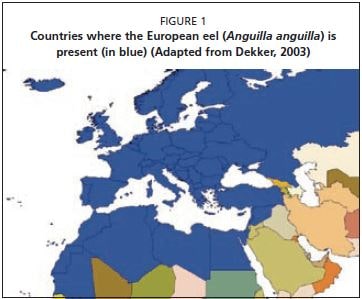Capture-based aquaculture of the wild European eel (Anguilla anguilla)
Thomas Nielsen
EUROEEL
Ascain, France
E-mail: Этот адрес электронной почты защищён от спам-ботов. У вас должен быть включен JavaScript для просмотра.
Patrick Prouzet
IFREMER Laboratoire halieutique d’Aquitaine
Anglet, France
E-mail: Этот адрес электронной почты защищён от спам-ботов. У вас должен быть включен JavaScript для просмотра.
Nielsen, T.; Prouzet, P. 2008. Capture-based aquaculture of the wild European eel (Anguilla anguilla). In A. Lovatelli and P.F. Holthus (eds). Capture-based aquaculture. Global overview. FAO Fisheries Technical Paper. No. 508. Rome, FAO. pp. 141–168.
SUMMARY
The European eel, Anguilla anguilla, has a long and complex biological cycle. Its area of distribution covers Europe, North Africa and Iceland. All its continental life stages are exploited by fishing, and human activities have dramatically reduced its habitat.
Farming of the European eel started some 25 years ago, and currently supplies approximately 45 000 tonnes/year which is >80 percent of the world’s consumption of the species. Farming techniques are now reliable, in both Europe and Asia, where most of the eels are produced. The industry is however still totally dependant on wild caught juveniles (i.e. glass eel) caught by fishers during their migration from the sea up freshwater rivers and streams. The main harvest is recorded in the river estuaries along the Atlantic coast.
Reproduction of Anguilla anguilla has not yet been achieved in captivity. The fishing for glass eel, along with environmental pollution and other human impacts, have all contributed to a significant decline in eel numbers over the last 25–30 years. Total volume of glass eels collected on an annual basis is around 150 tonnes which satisfies the current aquaculture needs of approximately 100 tonnes/year with the excess going to human consumption in Spain. Many people are involved in the eel collection, transportation and distribution, from glass eel fishers to the eel farmer and processor.
Aquaculture production presently satisfies the market demand, and no major new development is expected in the coming years. The feed sources for eel aquaculture are multiple and reliable. The only weak link in the chain is the supply of the wild-caught juvenile glass eels, which poses a real problem, as the eel is now considered “outside the safe biological limits and the current fisheries are not sustainable”.
In order to restore the eel population, the European Union (EU) has proposed a management plan which includes reducing the current harvest levels for all life stages and improving the carrying capacity of continental waters. The long term objective is to reach an escape level equal to at least 40 percent of the silver eel biomass produced in an undisturbed environment. This also includes some export restrictions of the glass eel to Asia or generally outside Europe in order to retain the wild seed in the region as much as possible for stocking and farming activities.
FIGURE 1
Countries where the European eel (Anguilla anguilla) is present (in blue) (Adapted from Dekker, 2003)
